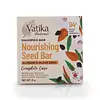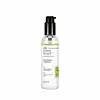What's inside
What's inside
 Key Ingredients
Key Ingredients

No key ingredients
 Benefits
Benefits

 Concerns
Concerns

 Ingredients Side-by-side
Ingredients Side-by-side

Sodium Cocoyl Isethionate
CleansingHydrogenated Vegetable Oil
EmollientWater
Skin ConditioningPolyglyceryl-4 Laurate
EmulsifyingGlycerin
HumectantCI 77004
Cosmetic ColorantPrunus Amygdalus Dulcis Oil
Skin ConditioningEthyl Macadamiate
Skin ConditioningParfum
MaskingTetrasodium Glutamate Diacetate
Nigella Sativa Seed Extract
PerfumingTocopherol
AntioxidantMalic Acid
BufferingCitric Acid
BufferingSodium Benzoate
MaskingPotassium Sorbate
PreservativeCoumarin
PerfumingSodium Cocoyl Isethionate, Hydrogenated Vegetable Oil, Water, Polyglyceryl-4 Laurate, Glycerin, CI 77004, Prunus Amygdalus Dulcis Oil, Ethyl Macadamiate, Parfum, Tetrasodium Glutamate Diacetate, Nigella Sativa Seed Extract, Tocopherol, Malic Acid, Citric Acid, Sodium Benzoate, Potassium Sorbate, Coumarin
Water
Skin ConditioningCocamidopropyl Betaine
CleansingDecyl Glucoside
CleansingSodium Cocoyl Isethionate
CleansingSodium Lauroyl Sarcosinate
CleansingCetyl Betaine
CleansingHydrolyzed Keratin
HumectantPhenoxyethanol
PreservativePanthenol
Skin ConditioningPolyquaternium-7
PEG-120 Methyl Glucose Dioleate
EmulsifyingXylitylglucoside
HumectantSalvia Sclarea Oil
MaskingCitric Acid
BufferingAnhydroxylitol
HumectantSodium Gluconate
Skin ConditioningLavandula Angustifolia Oil
MaskingMaltitol
HumectantBiotin
AntiseborrhoeicEthylhexylglycerin
Skin ConditioningXylitol
HumectantSodium Benzoate
MaskingPelvetia Canaliculata Extract
Skin ProtectingWater, Cocamidopropyl Betaine, Decyl Glucoside, Sodium Cocoyl Isethionate, Sodium Lauroyl Sarcosinate, Cetyl Betaine, Hydrolyzed Keratin, Phenoxyethanol, Panthenol, Polyquaternium-7, PEG-120 Methyl Glucose Dioleate, Xylitylglucoside, Salvia Sclarea Oil, Citric Acid, Anhydroxylitol, Sodium Gluconate, Lavandula Angustifolia Oil, Maltitol, Biotin, Ethylhexylglycerin, Xylitol, Sodium Benzoate, Pelvetia Canaliculata Extract
Ingredients Explained
These ingredients are found in both products.
Ingredients higher up in an ingredient list are typically present in a larger amount.
Citric Acid is an alpha hydroxy acid (AHA) naturally found in citrus fruits like oranges, lemons, and limes.
Like other AHAs, citric acid can exfoliate skin by breaking down the bonds that hold dead skin cells together. This helps reveal smoother and brighter skin underneath.
However, this exfoliating effect only happens at high concentrations (20%) which can be hard to find in cosmetic products.
Due to this, citric acid is usually included in small amounts as a pH adjuster. This helps keep products slightly more acidic and compatible with skin's natural pH.
In skincare formulas, citric acid can:
While it can provide some skin benefits, research shows lactic acid and glycolic acid are generally more effective and less irritating exfoliants.
Most citric acid used in skincare today is made by fermenting sugars (usually from molasses). This synthetic version is identical to the natural citrus form but easier to stabilize and use in formulations.
Read more about some other popular AHA's here:
Learn more about Citric AcidSodium Benzoate is a preservative. It's used in both cosmetic and food products to inhibit the growth of mold and bacteria. It is typically produced synthetically.
Both the US FDA and EU Health Committee have approved the use of sodium benzoate. In the US, levels of 0.1% (of the total product) are allowed.
Sodium benzoate works as a preservative by inhibiting the growth of bacteria inside of cells. It prevents the cell from fermenting a type of sugar using an enzyme called phosphofructokinase.
It is the salt of benzoic acid. Foods containing sodium benzoate include soda, salad dressings, condiments, fruit juices, wines, and snack foods.
Studies for using ascorbic acid and sodium benzoate in cosmetics are lacking, especially in skincare routines with multiple steps.
We always recommend speaking with a professional, such as a dermatologist, if you have any concerns.
Learn more about Sodium BenzoateSodium cocoyl isethionate is a natural ingredient from coconut oil. It is an ultra gentle cleanser that gives a nice foam without drying the skin or impacting the skin barrier.
The amount of foam created depends on the amount of sodium cocoyl isethionate used in the product.
This ingredient also helps improve the spreadability of a product.
Learn more about Sodium Cocoyl IsethionateWater. It's the most common cosmetic ingredient of all. You'll usually see it at the top of ingredient lists, meaning that it makes up the largest part of the product.
So why is it so popular? Water most often acts as a solvent - this means that it helps dissolve other ingredients into the formulation.
You'll also recognize water as that liquid we all need to stay alive. If you see this, drink a glass of water. Stay hydrated!
Learn more about Water